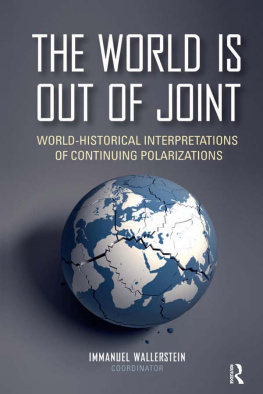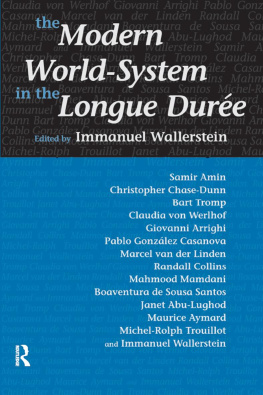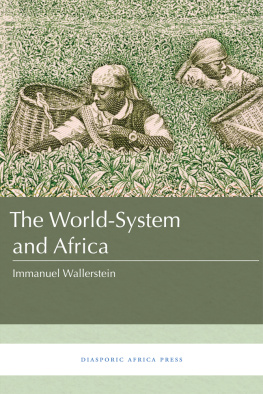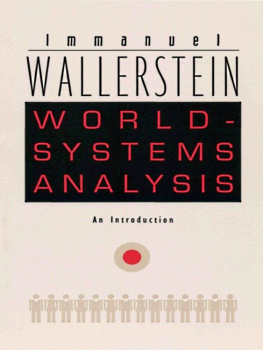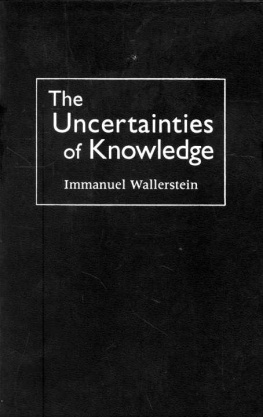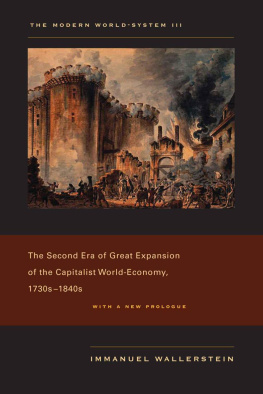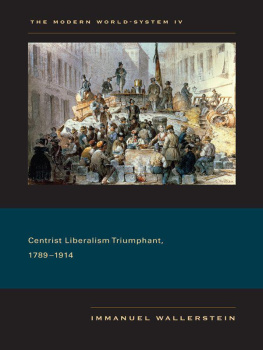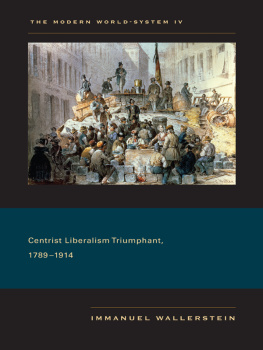
The World Is Out of Joint
Fernand Braudel Center Series
Edited by Immanuel Wallerstein
The World Is Out of Joint: World-Historical Interpretations of Continuing Polarizations
Immanuel Wallerstein, coordinator
Alternatives: The United States Confronts the World
by Immanuel Wallerstein
The Modern World-System in the Longue Dure
edited by Immanuel Wallerstein
Overcoming the Two Cultures: Science vs. the Humanities in the Modern World-System
Richard E. Lee and Immanuel Wallerstein, coordinators

The World Is Out of Joint
World-Historical Interpretations of Continuing Polarizations
Immanuel Wallerstein, coordinator,
and
Ana Esther Cecea
Roberto Patricio Korzeniewicz and Timothy Patrick
Moran
Peter J. Taylor, Michael Hoyler, and Dennis Smith
Eric Vanhaute, Hanne Cottyn, and Yang Wang
Jorge Fonseca
Ravi Sundaram
Atilio A. Boron and Paloma Nottebohm
Oleksandr Fisun and Volodymyr Golovko
Linda Christiansen-Ruffman
Ari Sitas, Sumangala Damodaran, Wiebke Keim, and
Nicos Trimikliniotis

First published 2015 by Paradigm Publishers
Published 2016 by Routledge
2 Park Square, Milton Park, Abingdon, Oxon OX14 4RN
711 Third Avenue, New York, NY 10017, USA
Routledge is an imprint of the Taylor & Francis Group, an informa business
Copyright 2015, Taylor & Francis.
All rights reserved. No part of this book may be reprinted or reproduced or utilised in any form or by any electronic, mechanical, or other means, now known or hereafter invented, including photocopying and recording, or in any information storage or retrieval system, without permission in writing from the publishers.
Notice:
Product or corporate names may be trademarks or registered trademarks, and are used only for identification and explanation without intent to infringe.
Library of Congress Cataloging-in-Publication Data
Wallerstein, Immanuel Maurice, 1930
The world is out of joint : world-historical interpretations of continuing polarizations / Immanuel Wallerstein, coord. and Ana Esther Cecea and 19 others.
pages cm. (Fernand Braudel Center series)
Includes bibliographical references.
ISBN 978-1-61205-717-0 (hardcover : alk. paper)
ISBN 978-1-61205-718-7 (pbk : alk. paper)
ISBN978-1-315-63100-4 (eBook)
1. Polarization (Social sciences) 2. Social structure. I. Wallerstein, Immanuel. II. Cecea, Ana Esther. III. Title.
HN18.3.W35 2014
301 dc23
2014017352
ISBN 13: 978-1-61205-717-0 (hbk)
ISBN 13: 978-1-61205-718-7 (pbk)

Contents
Chapter 1
Introduction
by Immanuel Wallerstein
Chapter 2
Ecology and the Geography of Capitalism
by Ana Esther Cecea
Chapter 3
Economic Inequality, Stratification, and Mobility
by Roberto Patricio Korzeniewicz and Timothy Patrick Moran
Chapter 4
Cities
by Peter J. Taylor, Michael Hoyler, and Dennis Smith
Chapter 5
Peasantries
by Eric Vanhaute, Hanne Cottyn, and Yang Wang
Chapter 6
Large Enterprises and Corporate Power
by Jorge Fonseca
Chapter 7
Intellectual Property
by Ravi Sundaram
Chapter 8
The States
by Atilio A. Boron and Paloma Nottebohm
Chapter 9
Citizenship
by Oleksandr Fisun and Volodymyr Golovko
Chapter 10
Womens Spaces and a Patriarchal System
by Linda Christiansen-Ruffman
Chapter 11
Deviance
by Ari Sitas, Sumangala Damodaran, Wiebke Keim, and Nicos Trimikliniotis
Chapter 12
Conclusion
by Immanuel Wallerstein

We collectively acknowledge gratefully the assistance of the Fundao Calouste Gulbenkian for its assistance in making possible the annual meetings of the coordinators of the research groups. We also wish to thank Joo Caraa of the Fundao for attending all of our annual meetings and for his very helpful participation in the discussions.

Chapter 1
Introduction
by Immanuel Wallerstein
Definition of the Intellectual Problem
Over the past two centuries, the dominant view in social science has been that the modern world shows a pattern of linear development in which all positive trends go upward in more or less linear fashion (albeit perhaps at an uncertain speed), and that therefore over time discrepancies between the leaders and the laggards are overcome, eventually resulting in a relatively homogenized world. By leaders and laggards, most analysts have been referring to states.
This view, which we may call the expectation of ultimate positive convergence of all states, reflects the Enlightenment belief in progress as the basic long-term pattern of social life. It was shared by classical and neoclassical economics, by what we now call Whig historiography, and by most of traditional sociology and anthropology. It dominated analysis throughout the world during most of the nineteenth and twentieth centuries.
There were, to be sure, conservative social thinkers who demurred. Some of them insisted that hierarchies were an inevitable (as well as desirable) feature of human social behavior. To the degree that the world seemed to move towards more egalitarianism, these thinkers argued this was a temporary deviation from the norm and that there would be a cyclical return to earlier patterns. However, generally after about 1850, this conservative demurral had little purchase in the emerging world of the social sciences.
Classical (or orthodox) Marxism offered its doctrines as a refutation of liberalism and its Weltanschauung. Nonetheless, it shared by and large the same belief in the inevitability of progress and the linear upward pattern of social processes. Marxist differences with liberalism consisted primarily of an argument about the motor forces of this progression as well as many of the details being described.
This widely shared view of ultimate positive convergence of all states grew steadily stronger in the period 18501950, and seemed to reach an apotheosis in the twenty-five years following the end of the Second World War. The problem in this last period was the growing empirical evidence that the gap between what was called at the time the developed and the underdeveloped nations was increasing rather than decreasing as the dominant view had theorized.
As a consequence, in the post-1950 period, a number of analysts began to contest this linear model, but in a new way, not employing the version of the conservative demurral. The linear progress model viewed the modern world as a process of homogenization and therefore one of overcoming the gaps between states or groups of any kind. Against this view, many social scientists began to argue that the modern world was one of heterogenization and polarization. Indeed, they said, the pattern of polarization escalated over time, the result of the way in which the modern world was structured.
Next page
